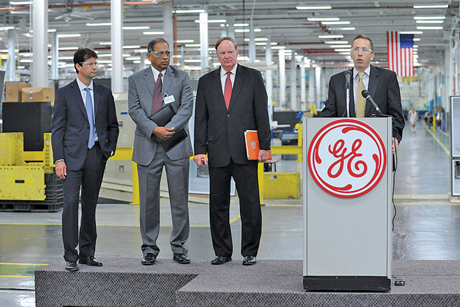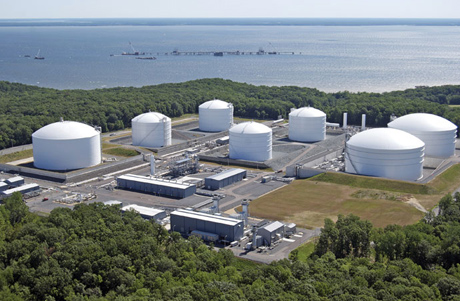Utilities today grapple with such thorny issues as EPA regulations, data center demand, customer demands for renewables and lower costs, the on again/off again comeback of nuclear power, catching up with infrastructure investment, and increasing power demand from increasingly populous territories. They might be forgiven for putting economic development on the back burner as they simply stick to the core business of keeping the power and gas flowing.
Then again, even back burners need power and gas. And the converse is true too: The utility business needs the burners that economic growth produces.
Duke Energy knows about growth, having not only shepherded its share in Duke territory, but also gone through its share of mergers and acquisitions. The biggest one yet just closed this summer, as Charlotte-based Duke acquired Raleigh-based Progress Energy — and suddenly had 7.1 million customers.
“The benefits of this merger to our customers, employees, communities and investors are compelling,” said Duke Chairman, President and CEO Jim Rogers on Aug. 2, “and we have a talented team of employees working aggressively to achieve them.”

One of them, Clark Gillespy, was promoted earlier this year to president of Duke Energy – South Carolina. His previous post was as Duke Energy Carolinas’ vice president of economic development, business development and territorial strategies. Duke has been named a Top Utility in Economic Development in these pages many times in the past. So has Progress. That common excellence will serve as a strong foundation for the merged teams.
“I had the opportunity to serve on the merger and integration team over the 18-month period it took to put it together,” says Gillespy, noting the two utilities’ past friendships and collaborations in economic development as well as their competition. He says it’s an opportunity to take best practices from both companies and adapt them across the board in the diverse territories of the Carolinas, Indiana, Ohio, Kentucky and Florida.
Gillespy met with site consultants from across the nation during the M&A process, asking them what the economic development team should look like and what kinds of services it needed to offer.
“The resounding theme was, ‘Get the burger to taste the same,’ ” he says. “They’ve come to a certain expectation level from Duke Energy, and they want that same level of expertise across the entire service footprint, which has doubled in size.”
One best practice that will roll out across that footprint is Duke’s Site Readiness program, which over seven years has assessed 86 sites, and helped land nine projects that created over $2 billion in capital investment and more than 1,000 jobs. Gillespy is anxious to see that program hit the ground running in Florida.
“Our team has already been down there twice, and will be down there five more times in very short order,” he says. “We’re already creating a site portfolio for Florida, which they have not had before.”
Asked what Duke learned from its previous large merger — with Cinergy in 2006 — Gillespy says that given the diverse territories of the Midwest and the Carolinas, “We pretty much left it to the economic development teams to run almost independently. But we found that by doing that, we left a fair amount of bench strength on the sideline, and we could have learned from each other. With this merger, we had very collaborative meetings back and forth, and we learned we have a lot more similarities than differences.”
Gillespy’s promotion itself speaks to the priorities of the newly merged entity. “Duke has sent a clear message that economic development is core to our business,” he says. “My replacement should be named in fairly short order, and will be someone with a great deal of experience who will be welcomed by the economic development community. This comes from the top down, and that’s the most comforting in all of this. Jim Rogers even gets involved with some of our projects. With anything, that makes a huge difference.”
Below, in alphabetical order, we present the Top Utilities in Economic Development for 2012, selected by the following mix of objective and subjective criteria: Analysis of corporate end-user project activity in 2011 in that company’s territory; website tools and data; survey input from site location decision-makers; innovative programs and incentives for business, including energy efficiency and renewable energy programs; and the utility’s own job-creating infrastructure and facility investment trends.
________________
Ameren
St. Louis, Mo.
www.ameren.com/ecdev
Ameren’s energy operating companies serve 2.4 million electric customers and 900,000 natural gas customers across 64,000 sq. miles (165,760 sq. km.) in central and southern Illinois, mid-Missouri and the St. Louis metropolitan area. Its economic development efforts in 2011 helped foster more than $1.3 billion in corporate investment and create 3,432 jobs, including such projects as Archer Daniels Midland in Decatur, Ill.; Continental Tire in Mt. Vernon, Ill.; GM in Wentzville, Mo.; and Anheuser-Busch subsidiary Metal Container in Arnold, Mo.
In addition to its popular ActOnEnergy efficiency program and LocationOne site location database and Partners in Development community support programs, Ameren in 2011 and early 2012 has launched major 10-year grid modernization programs in both Illinois and Missouri. And its ATX affiliate is pursuing an equally aggressive $1.2-billion menu of transmission improvements across the utility’s bi-state territory. Finally, communities are benefiting from Ameren’s quality of labor reports, which use a proprietary Ameren survey instrument to capture regional benchmark data on multiple qualitative workforce characteristics and to quantify skill levels, availability and cost.
Like several utilities on this list, Ameren likes to loan out its leaders. Ameren Chairman, President and CEO Tom Voss serves as chairman of the St. Louis Regional Chamber and Growth Association (RCGA). And in June of this year, in the name of regional solidarity, Ameren loaned one of its Ameren Illinois veterans — Rich Conner, superintendent of administration for its Division V territory — to RCGA’s St. Louis office to serve as senior advisor on regional development, a newly created position. “By building a better region, we build a better future,” said Voss.
________________
American Electric Power
Columbus, Ohio
www.aeped.com
When you deliver power to customers in 11 states, coordinating economic development can be a challenge. But with 38,000 MW of generating capacity and a 39,000-mile (62,751-km.) transmission network with more 765-kilovolt extra-high voltage transmission lines than all other U.S. transmission systems combined, it’s a good challenge to have.

Cited by several polled site selection consultants among their top five utilities in economic development, AEP offers a full suite of site selection services through its seven affiliates, including Shreveport-based Southwestern Electric Power Co. (Ark-La-Tex region), Appalachian Power (parts of Virginia, West Virginia and Tennessee) and Fort Wayne-based Indiana Michigan Power (northeast Indiana and southwest Michigan). The utilities’ services include follow-through programs such as SWEPCO’s Commercial & Industrial Energy Efficiency Program. AEP Ohio, the AEP system’s largest unit, serves 1.5 million of the system’s more than 5 million customers. A 2011 report found that its $8.4 million in community contributions included $2 million toward economic development. In March 2011 it expanded its energy efficiency program to small business customers. And its electric security plan filed with regulators included the new Ohio Growth Fund, a $25-million shareholder contribution designed to support economic development.
AEP’s efforts are receiving added emphasis with the recent hiring of Mark James to lead the system’s economic development efforts, as well as the hiring of John Smolak to lead economic development for Appalachian Power. “In today’s economy, it is more important than ever that we support local, state and regional economic development efforts to attract new business, help companies expand their operations in our service territory, and create jobs,” said Robert P. Powers, AEP executive vice president and COO.
________________
CenterPoint Energy
Houston, Texas
www.centerpointenergy.com/ecodev
The utility serving the 10-county Houston region in 2011 helped bring in more than $1.5 billion in private-sector project investments that are creating 14,158 jobs, and generated 113 project leads for the region. Notably, CenterPoint last year became the first utility in the U.S. to receive the Accredited Economic Development Organization designation from the International Economic Development Council.
As the utility’s 2011 regional project report expressed it, “If 2010 marked a year of recovery for Houston, 2011 marked the transition to full-blown expansion.”
By the close of the year, the region had gained 76,700 jobs. Specifically, notes the report, “After reaching a low of 70 in 2009, the number of jobs per project for the overall region has steadily risen. In 2010, the average reached 92 and climbed over 30 percent to 120 jobs per project in 2011. This is the highest the metric has been since Economic Development began compiling this data and suggests the rise of larger projects.” Of the new projects landed across the region, 43 percent were concentrated in the manufacturing and petrochemicals sectors.” Expansions accounted for 64 percent of the new jobs.
________________
Duke Energy
Charlotte, N.C.
www.LocationDukeEnergy.com
Duke in 2011 helped attract corporate projects worth nearly $4 billion that are creating 13,365 jobs in its five-state territory. The utility serves some 4 million customers, more than half of them in the Carolinas. The utility assisted an impressive array of companies in 2011, though details are confidential.
Since its inception in 2005, Duke Energy’s Site Readiness Program has identified and performed assessments on approximately 90 industrial sites and 5 potential mega-sites across the Carolinas, including seven new sites to be evaluated in 2011. Last year Duke expanded this program into its Ohio/Northern Kentucky region and evaluated six sites in the region, with additional sites planned for 2012.
In the work force arena, Duke’s NC Community and Technical College Grant Program and AdvanceSC effort in South Carolina have continued to reap dividends for communities. In Indiana the utility’s economic development staff continue to help lead such organizations as Accelerate West Central Indiana, and to develop new solutions such as a communications template that allows site and rate information to be sent electronically to team members, state officials and site consultants.
But leadership may be Duke’s strongest suit: In addition to the Clark Gillespy promotion discussed above, many of the company’s economic development leaders take on strong roles. They include David Smith, director of economic development in the Ohio/Kentucky region. In addition to having founded the successful Ohio Business Development Coalition, he currently serves as chair of Cincinnati USA and as president of the Utility Economic Development Association.
_______________
Entergy
New Orleans, La.
www.entergysiteselection.com
and
www.entergy.com/our_community/economic_development.aspx
Private-sector facility investment totaling nearly $2.3 billion and creating 8,877 jobs boosted the economic health of Entergy’s territory in Arkansas, Louisiana, Mississippi and east Texas. Projects came from DG Foods, Ormet and Petroplex in Louisiana; Motiva, Lanxess and CorroTube in Texas; and Tyson, Dillard’s and Albemarle in Arkansas.
Eight was a magic number in Louisiana, where the Entergy team identified and qualified eight new target industries, and also championed eight sites that were ultimately certified by Louisiana Economic Development as ready for development. Entergy’s Teamwork Arkansas worked with PR firm The Markham Group to help Little Rock, Newport and Jefferson County pass ballot measures for an economic development sales tax. The measures will mean $68 million in economic development funds in the three communities over the next 8-10 years. Other communities are now considering the tax idea, and looking to Entergy’s Teamwork Arkansas for guidance.
________________
FirstEnergy
Akron, Ohio
www.firstenergycorp.com/ed
FirstEnergy’s 10 electric utility operating companies — including Ohio Edison, Potomac Edison and Met-Ed in Pennsylvania — serve 6 million customers across six states, and in 2011 the company’s economic development team served up over $1.7 billion in corporate facility project activity, expected to create 7,448 jobs. The project list includes major investments from Watson Pharmaceuticals in New Jersey; Rieter Automotive, Johnson Controls and Miceli Dairy Products in Ohio; and Gardner Denver and Calfrac Well Services in Pennsylvania.
The company’s economic development team remains active in such efforts as the NJ Clean Cities Coalition; Akron’s Project Get Ready effort to prepare for electric vehicle infrastructure; and the Tech Belt Initiative to help reinvigorate the electric generation supply chain in Ohio and Pennsylvania.
Among other activity, following its recent merger with Allegheny Energy, FirstEnergy added economic development professionals in Maryland, West Virginia and Pennsylvania. As part of its Export Now program, FirstEnergy Economic Development sponsored six industrial customers, from the states of Ohio, Pennsylvania and New Jersey, to participate in the US Commercial Service’s Mexico & the Americas Trade Winds event.
As part of its electric security plan in Ohio, FirstEnergy has pledged $3 million towards economic development that will be used to provide assistance for economic development projects or economic development efforts in its service territory in Ohio. Those funds and others are part of a $10-million pledge to the Austen BioInnovation Institute of Akron, in FirstEnergy’s hometown.
________________
Georgia Power
Atlanta, Ga.
www.SelectGeorgia.com
This utility’s Community & Economic Development team helped attract nearly $2.38 billion in private-sector project investment in 2011 that is projected to create 10,231 jobs. Those projects, some 80

in all, came from the likes of Kia in West Point, ThyssenKrupp in Alpharetta, Koyo Bearings in Dahlonega and Lowe’s in Rome.
Internally, the team saw the debut of new civil engineering site optimization software and virtual environments, a new SelectGeorgia website, and a new automotive industry briefing and industry report. In addition to hosting prospects at its Georgia Resource Center, Georgia Power’s services include engineering and site design services; governance training for elected officials; urban design, planning and project development guidance; and work-force analysis.
In the renewables arena, Georgia Power continues to pursue a number of pilot programs and studies in deployment of solar, biomass, landfill gas and wind, and continues to draw on its 2,758 MW of hydroelectric power, which rank it seventh in the nation in hydro generation.
But its biggest ace in the hole is the $14-billion expansion at the Plant Vogtle nuclear power plant, which earned its combined operating license some time ago and continues to move forward even as other utilities now must endure a Nuclear Regulatory Commission moratorium on such licenses.
________________
LG&E/KU
Louisville, Ky.
www.site-selection.com
In 2011, 54 new companies and 272 expansion projects were announced in Kentucky, resulting in 13,230 jobs and more than $2.6 billion in investment. The team at LG&E/KU helped many of those projects get to the finish line as deals and the starting line as viable and productive operations.

Now part of PPL Corp., LG&E and Kentucky Utilities continue a Commonwealth tradition of top-shelf economic development. Among its newest traditions is a “Business in Your Backyard” video series profiling some of its 400 Major Accounts customers. “These customers alone use approximately one million megawatt hours per month,” says the company.
LG&E and KU recently launched a deep site and building database using the LocationOne system. In response to commercial customer requests, LG&E and KU will offer customized rebates for energy-saving measures beyond the current qualified list implemented by commercial customers. New incentives include a Brownfield Development Economic Development Rider available for billing loads of 500 kVA (or kW as is appropriate) or greater where the customer takes service from existing company facilities.
Kentucky Utilities recently opened a new, consolidated business and operations center in Morganfield that will house 75 employees. It’s KU’s fourth center in Kentucky, and it fields calls from across LG&E/KU’s 94-county territory.
________________
Progress Energy
Raleigh, N.C.
www.progress-energy.com/economic
Now being merged with acquirer Duke Energy’s equally prize-winning economic development squad, Progress Energy’s team went out with a bang in 2011, helping companies create 5,136 jobs via nearly $1.3 billion in projects, including Continental Tire and Georgia-Pacific in South Carolina; Red Hat and Linamar in North Carolina; and Prime Therapeutics and Dynamet in Florida.
Progress Energy provided advocacy for legislation passed in 2012 to expand South Carolina’s License Fee Credit program in terms of funding levels and eligible projects. The program allows utilities to channel license fee credits toward job-generating economic development projects. Progress also continued to lead Raleigh’s claim as a smart grid and electric vehicle R&D capital.
Like Duke, Progress Energy prided itself on voluntary involvement of its leaders. Stuart Ames, economic development manager in South Carolina, was selected by the South Carolina Department of Commerce as Florence County’s Economic Development Ambassador of the Year. And Marc Hoenstine, economic development manager in Florida, received the Florida Economic Development Council’s 2012 Regional Director of the Year award for his service to the Tampa Bay and East Central Region.
________________
Tennessee Valley Authority
Nashville, Tenn.
www.tvaed.com
In a Nov. 2011 paper, co-authors Patrick Kline and Enrico Moretti called the TVA “one of the most ambitious place-based economic development policies in the history of the United States.” TVA’s economic development team, which helped garner $4.9 billion and 43,000 jobs for its region last year, is doing nothing to quell that ambition.
TVA continues to set the table for economic growth across its 80,000-sq.-mile (207,200-sq.-km.) territory in parts of seven states, as it provides power directly to 56 large industries and 155 power companies. Among the major projects to land in TVA territory in 2011 were Olin-Winchester and GE Aviation in Mississippi; GM and Martinrea Hopkinsville in Kentucky; Topre America and North American Lighting in Alabama; and Electrolux and Amazon.com in TVA’s home state of Tennessee.
Valley Investment Initiative incentives in 2011 captured more than 31,000 created and retained jobs and $2.9 billion in investment. TVA Economic Development worked with Deloitte to implement a data center site identification program, thus far qualifying 20 primary sites and expecting to qualify more. Advanced manufacturing has been added as a new target industry. The team also held its first Rural Leadership Institute, part of an expanded Rural Development Strategy. Finally, TVA Community Development staff conducted 107 training and development workshops in the TVA region in order to prepare communities for growth opportunities.

Honorable Mention Utilities
|
________________ Alabama Power ________________ Dominion Virginia Power ________________ Hoosier Energy ________________ Mississippi Power ________________ National Grid |
________________ Northeast Utilities ________________ NV Energy ________________ Portland General Electric ________________ Santee Cooper/South Carolina Power Team ________________ Xcel Energy |
